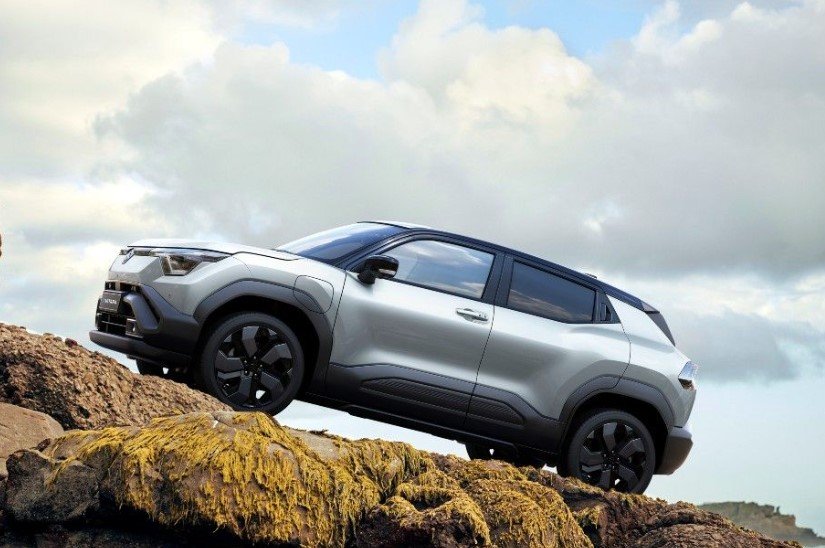India’s auto giant trims first-half electric SUV production by over 65% as supply snags hit e-Vitara launch plans
India’s largest carmaker, Maruti Suzuki, has been forced to dial back its electric dreams—at least for now. Production targets for its much-hyped e-Vitara SUV have taken a major hit due to a worsening supply crunch of rare earths, materials vital to the electric vehicle (EV) ecosystem.
Despite initial claims that operations were unaffected, internal documents reviewed by Reuters show the company is preparing to produce just 8,200 units in the first half of FY25–26. That’s a steep drop from the original goal of 26,500 vehicles. The cut is a direct response to export restrictions imposed by China, the world’s dominant supplier of rare earth magnets.
First signs of strain on India’s electric vehicle ambitions
In public, Maruti maintained a confident stance. Just this week, the company asserted that the rare earth crunch hadn’t impacted its pipeline. But behind the scenes, a different picture was unfolding.
According to internal communications accessed by Reuters, “supply constraints” were cited as the main reason for the production cut. The primary bottleneck? A shortage of magnets and motor components dependent on neodymium and other rare earth elements.
This marks a rare production scale-back for a company that has long enjoyed smooth scaling, particularly as it finally entered the EV race. For India’s EV sector, still in its early innings, the news lands like a warning bell.

China’s export policy casts a long shadow
The real sticking point is 3,800 km away—in Beijing. In late 2024, China tightened its export controls on rare earth materials, citing “national security” concerns. Since then, automakers around the world have scrambled to secure alternate supplies or licenses from Chinese authorities.
Some automakers in the US, Japan, and Europe have managed to obtain short-term export licenses. But India hasn’t been so lucky.
For now, Indian manufacturers, including Maruti, are stuck in limbo. Industry executives say that applications for export clearance have been submitted, but approvals are still pending. There’s growing anxiety that continued delays could cripple India’s fledgling EV roadmap.
One executive, speaking anonymously, admitted, “We were hopeful, but now we’re preparing for longer delays. It’s not just a Maruti problem—it could hit others soon.”
Catch-up later, if possible
Despite the gloomy start, Maruti hasn’t altered its full-year ambitions just yet. The company is sticking with its initial annual target of producing 67,000 units by March 2026. That means it’ll need to make up for lost time in the second half of the fiscal year.
Whether that’s feasible remains to be seen.
• The first-half cutback stands at 69%
• Maruti now needs to manufacture roughly 58,800 e-Vitaras in just six months
• That’s almost 10,000 units per month, compared to fewer than 1,500 in the first six months
It’s a tall order, especially if rare earth supply issues continue into the next quarter.
An industry-wide ripple effect
Maruti may be the most high-profile name in this story, but it’s not the only one feeling the heat. Other Indian automakers are quietly reviewing their production schedules, especially for upcoming EV models.
Meanwhile, two-wheeler EV makers are reportedly scouting alternative motor suppliers from South Korea and Vietnam. But those options come with their own set of complications—higher costs, shipping delays, and limited capacity.
Let’s take a look at the EV production plans of key Indian players for FY25–26:
| Automaker | EV Production Target | Status Update |
|---|---|---|
| Maruti Suzuki | 67,000 | Cut Q1-Q2 target, full-year unchanged |
| Tata Motors | 125,000 | On track, but watching supply closely |
| Mahindra & Mahindra | 40,000 | Evaluating impact of rare earths issue |
| Ola Electric | 200,000+ (2Ws) | Exploring alternate motor sources |
As one analyst put it, “There’s a supply chain reckoning coming. India doesn’t control the magnets—and that’s the magnet pulling everything out of balance.”
Scramble for local alternatives begins—but it’s not easy
India has been pushing for rare earth self-reliance for over a decade. But progress has been slow, tangled in environmental clearances, tech gaps, and political hesitations.
Now, with the EV boom gathering pace, pressure is mounting to speed things up.
The Indian government has launched several initiatives to ramp up domestic rare earth processing. Companies like IREL (India) Ltd have been tasked with boosting capacity, but these efforts are still in early phases. At best, they’re a few years away from scale.
For now, auto companies have limited options:
-
Wait for China to resume exports.
-
Absorb higher costs from alternate suppliers.
-
Postpone launches or reduce production targets.
None of those are ideal. And none are fast.
Maruti’s EV debut hits a speed bump, but the road ahead is long
The e-Vitara was supposed to be Maruti’s bold foray into India’s competitive EV space—a space where it’s already late to the party. Now, with its rollout disrupted just months into launch, the timing couldn’t be worse.
Still, industry watchers aren’t writing Maruti off just yet. The company’s strong dealer network, brand trust, and pricing strategy could give it an edge once the supply bottlenecks ease.
